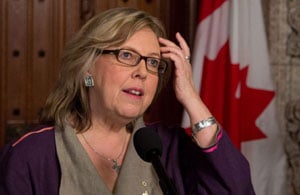
What would the House of Commons look like with the addition of a few dozen Green MPs? Under any kind of minority government, a Green caucus led by Elizabeth May would wield outsized political clout. For example, they could demand important environmental policy commitments every time they helped pass a government bill.
This could be reality in four years or less, if Green Party members in a few key ridings play their cards right.
Here's the situation. The Greens hold just two seats out of 308 in Ottawa -- one secured by Elizabeth May in 2011 and the other courtesy of Bruce Hyer, the former NDP MP for Thunder Bay who sat as an independent before joining May as a Green.
That's just 0.6 per cent of seats, despite the Greens polling as high as 10 per cent nationally. One survey commissioned by the party found as many as three in 10 Canadians would consider voting Green. What holds them back is Canada's first-past-the-post voting system, under which Green candidates almost never have enough concentrated support in a single riding to win.
That's why Greens are strongly in favour of proportional representation. Under pro-rep if 30 per cent of voters really did go Green, they would win roughly 30 per cent of the seats. In the expanded 338-seat House of Commons, that would translate to a massive 100-person caucus.
It will never happen, however, unless Canada's voting system changes. That's why Greens interested in becoming a serious force in Ottawa should do everything they can to win commitments on democratic reform from other parties. And with a federal election coming up, the Greens might have more leverage than many realize.
The NDP is already on side. Tom Mulcair has promised proportional representation in the first term of any government formed by the NDP. The Conservatives, on the other hand, have every reason to keep the current arrangement. So the key player in changing the voting system is Justin Trudeau.
After the 2011 election the Liberals were in disarray. With only 34 seats and no permanent leader, the party grassroots became suddenly interested in -- you guessed it, electoral reform. Prominent Liberals like Bob Rae, Stephane Dion and Joyce Murray emerged as advocates for a more proportional voting system.
Since then the Liberal brand has rebounded and polls show the party within striking distance of a majority government. Unsurprisingly, leader Justin Trudeau says he's opposed to electoral co-operation with other parties, opposed to coalition government and will only agree to "study" proportional representation after the next election.
But Trudeau's caucus is split. In December, 16 Liberals voted in favour of an NDP motion calling for the immediate creation of a mixed-member proportional representation system similar to what is used in Scotland, New Zealand and Germany. It wouldn't take much to tip the Liberal caucus and convince Trudeau to change his tune.
Contenders or spoilers?
Back to the Greens. Since Elizabeth May's historic 2011 election victory in Saanich-Gulf Islands, Green parties have been on a bit of a roll. They've enjoyed wins in the B.C. provincial election (Andrew Weaver), New Brunswick (David Coon)* and Vancouver's municipal election (Adriane Carr, Janet Fraser, Stuart Mackinnon, Michael Wiebe).
The federal party also came close in a couple of byelections. In November 2012 Donald Galloway nearly stole Victoria from the NDP's Murray Rankin. And in Calgary Centre, Conservative candidate Joan Crockatt won with 10,191 votes to 9,033 for Liberal Harvey Locke and 7,090 for Chris Turner of the Greens.
Liberals howled that the vote-split had cost them a powerful symbolic win in the Conservative heartland of Alberta. They blamed the Greens for playing the spoiler. Regardless of whether that's true, Greens ought to find more ridings like Calgary Centre and start horse-trading.
For starters there were eight ridings in the last election where a Conservative won, but the combined Green and Liberal vote count was actually higher. If you transpose those 2011 results onto the new, 338-seat election map, there are 10 ridings where Greens and Liberals together add up to a win. In eight more ridings they'd be within a thousand votes.
Nobody is suggesting that in the absence of a Green candidate, every single one of those supporters would vote Liberal. But there is overlap, which has led the two parties to co-operate before.
The ask for Trudeau
In 2008 the Liberals chose not to field a candidate in Central Nova, as Elizabeth May took a run at Conservative MP Peter MacKay. The Greens surged by 12,000 votes, which was more than the Liberals' entire vote count in the previous election. In 2013 the Greens opted out of the Labrador byelection, urging supporters to vote for Liberal candidate Yvonne Jones. The Green vote may not have been decisive, but Jones beat the Conservative incumbent.
Now the Liberals are eyeing dozens of ridings in the Maritimes, Vancouver, Montreal, Ottawa, Toronto and the 905 where even a modest bump in votes could carry them over the top. In many of those places the Greens could destabilize races the Liberals are gunning to win. What would Trudeau's party trade for one fewer competitor on the ballot?
Speaking generously, the Greens have a decent shot in perhaps a dozen ridings. The party doesn't have the resources to run 338 serious campaigns, and the incentive to run long-shot candidates disappears this year with the end of the per-vote subsidy. But that lack of capacity could be a major asset, if other parties can be drawn into negotiations about where Green candidates choose to sit out.
With the Liberals, the ask is clear: Greens need a commitment on proportional representation from Justin Trudeau, so the next election isn't fought under first-past-the-post.
Nominations for the next election are in full swing, creating a strategic dilemma for grassroots Greens. Is it nobler to keep struggling under the current voting system? Or would it make more sense to strike a deal this year with the Liberals, setting up the next election to be fought under some form of proportional representation?
The decision could make a difference of 98 seats.
Please note our comment threads will be closed Dec. 22 to Jan. 5 to give our moderators a well-deserved break. Happy holidays, readers.
*Story corrected Dec. 31 at 12:20 p.m. ![]()
Read more: Federal Politics














